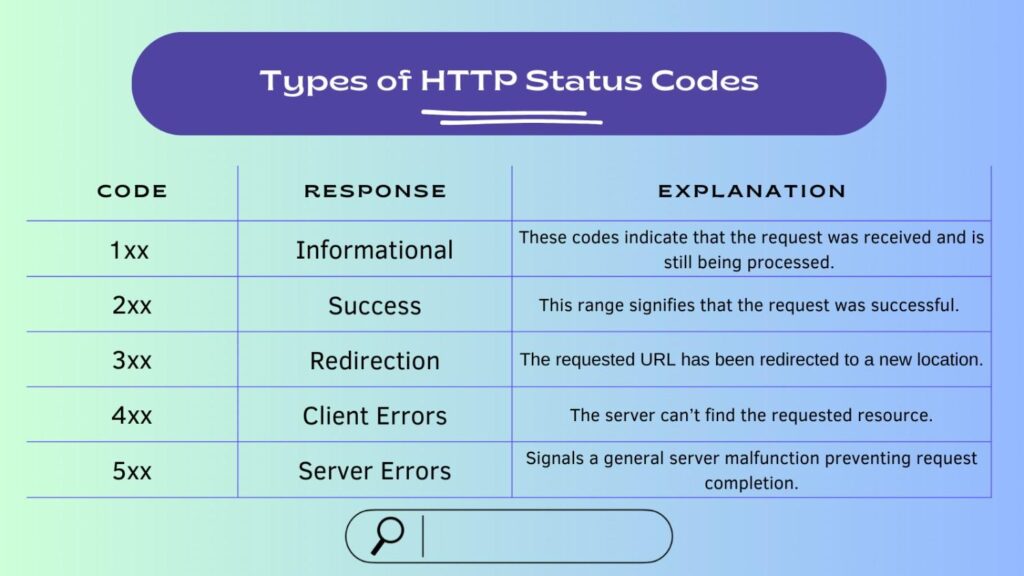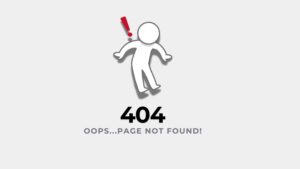When it comes to SEO, understanding how search engines see your website is essential, and HTTP status codes play a big role in that. These codes are messages your server sends to browsers, giving them a quick update on what’s happening when someone visits your site. Some of these codes can help your SEO efforts, while others can harm them, leading to drops in rankings, poor user experience, or even penalties. In this guide, we’ll break down the most common HTTP status codes, explain what they mean, and show how they directly impact your website’s SEO performance.
What Are HTTP Status Codes and Why Do They Matter for SEO?
HTTP status codes are standardized responses issued by a web server to indicate the result of a client’s request to access a resource. They provide essential information about the outcome of a request, such as whether it was successful, encountered an error, or was redirected.
These codes also influence SEO rankings. Mastering these codes is crucial for any business aiming to enhance overall user satisfaction.
What are HTTP status codes?
Let’s take a closer look at some essential HTTP status codes. These codes are integral to effective troubleshooting
- 200 (OK): This code signifies that the server successfully processed a client’s request. It indicates that the requested resource is available and that the server has returned the appropriate response. For SEO, a 200 status code is essential, as it confirms that search engines can access and index the webpage’s content.
- 301 (Moved Permanently): A 301 status code indicates that a page has been moved to a new URL permanently. This code informs search engines and browsers to redirect users to the new address. 301 redirects are crucial for maintaining SEO equity, as they transfer link juice from the old URL to the new one, helping preserve rankings.
- 404 (Not Found): This code is returned when a requested resource cannot be found on the server. A 404 error can negatively impact user experience and SEO performance, as it indicates broken links or missing content. Proper handling of 404 errors is important to guide users back to functional areas of the site and maintain search engine credibility.
- 500 (Internal Server Error): This status code signifies that the server encountered an unexpected condition that prevented it from fulfilling a request. A 500 error indicates a problem with the server, which can lead to a poor user experience and hinder SEO efforts. Diagnosing and fixing the underlying issues causing a 500 error is vital for website performance and functionality.
How Search Engines Interpret Status Codes
Search engines rely on HTTP status codes to understand how to interact with websites. Each code communicates specific information about the request made and the server’s response, influencing how search engines crawl and index web pages.
For instance, a 200 status code indicates a successful request, prompting search engines to index the content, while a 404 code signals that a page is missing, leading search engines to potentially reduce the site’s overall ranking if numerous pages return this status.
If a search engine encounters frequent errors, it may view the site as unreliable, negatively impacting its ranking. By effectively managing HTTP status codes, businesses can enhance their site’s visibility, ensuring that search engines can properly index their pages and improve user experience.
SEO Implications of Misconfigured HTTP Status Codes
Misconfigured HTTP status codes can significantly challenge a website’s search engine optimization. Understanding these implications is essential for maintaining a robust online presence.
- Reduced Crawl Efficiency: When status codes are incorrectly set, search engine bots may face obstacles during the crawling process. For instance, if a page returns a 404 error instead of a 200 status code, it may prevent search engines from indexing that page. Engaging professional SEO services can help identify and rectify these issues to ensure optimal crawl efficiency.
- Loss of Link Equity: Using a 302 temporary redirect instead of a 301 permanent redirect can lead to significant link equity loss. This means that the authority built by backlinks to the original page may not be transferred to the new URL, weakening its ranking potential.
- Increased Bounce Rates: Incorrect status codes can frustrate users, leading them to abandon the site quickly. If visitors encounter a 500 server error, they are likely to leave, increasing bounce rates. High bounce rates can signal to search engines that the site lacks quality content, which can further harm SEO rankings.
- Poor User Experience: When users encounter issues due to misconfigured status codes, their overall experience on the site diminishes. A negative user experience can lead to decreased engagement and lower conversion rates, affecting the business’s online success. Addressing these codes promptly is crucial to maintaining a positive user journey.
Types of HTTP Status Codes and Their Significance
HTTP status codes help servers communicate with browsers and search engines. They indicate whether a request has been successfully processed or if there’s an issue that needs attention. Understanding the different types of status codes and their significance can improve your site’s performance and help optimize your SEO efforts.

Complete List of HTTP Status Codes
Below is an overview of various HTTP status codes and their meanings:
1xx: Informational
- 100 Continue: The server has received the request headers and is waiting for the body.
- 101 Switching Protocols: The client requested a protocol switch, and the server agreed.
- 102 Processing: The server is still working on the request but hasn’t completed it yet.
2xx: Success
- 200 OK: The request was successful, and the server returned the requested resource.
- 201 Created: The request succeeded, and a new resource has been created.
- 202 Accepted: The request has been received but is still being processed.
- 203 Non-Authoritative Information: The request was successful, but the response may have been sourced from elsewhere.
- 204 No Content: The server processed the request but has no content to return.
- 205 Reset Content: The server processed the request and asks the client to reset its document view.
- 206 Partial Content: The server is delivering a part of the resource, often due to large file transfers with range headers.
- 207 Multi-Status: The response includes multiple status codes, usually in WebDAV operations.
- 208 Already Reported: The DAV members have already been reported in an earlier response (WebDAV).
- 226 IM Used: The server successfully fulfilled a GET request using an instance-manipulation response.
3xx: Redirection
- 300 Multiple Choices: The resource has several options, and the client can select one.
- 301 Moved Permanently: The requested resource has been permanently relocated to a new URL.
- 302 Found (Temporary Redirect): The resource is temporarily available at a different URL.
- 303 See Other: The client should use a GET method to retrieve the resource at another URI.
- 304 Not Modified: The resource has not changed since the last request, often for caching purposes.
- 307 Temporary Redirect: Similar to 302, but the request method (e.g., POST or GET) remains unchanged.
- 308 Permanent Redirect: The resource has been permanently moved to a new location, and the request method should not change.
4xx: Client Errors
- 400 Bad Request: The server couldn’t process the request because it recognized an issue it considered a client error.
- 401 Unauthorized: Authentication is necessary to access the resource.
- 402 Payment Required: Reserved for future use, often related to digital payment systems.
- 403 Forbidden: The server is operational, but access to all or part of the site has been restricted due to permission changes.
- 404 Not Found: The server is unable to locate the requested resource.
- 405 Method Not Allowed: The requested method (e.g., GET, POST) is not permitted for the resource.
- 406 Not Acceptable: The requested resource can only produce responses that are not acceptable to the client.
- 407 Proxy Authentication Required: The client must authenticate with a proxy before the request can be processed.
- 408 Request Timeout: The server timed out while waiting for the request.
- 409 Conflict: It indicates a conflict with the current state of the resource.
- 410 Gone: The resource is no longer available and will not be returning.
- 411 Length Required: The server declines to process the request due to the absence of a specified Content-Length header.
- 412 Precondition Failed: This code signifies that access to the target resource has been denied.
- 413 Payload Too Large: The request entity exceeds the limits the server is willing to process.
- 414 URI Too Long: The provided URI is too lengthy for the server to process.
- 415 Unsupported Media Type: The server cannot support the media format of the requested data.
- 416 Range Not Satisfiable: The server could not fulfill the requested ranges.
- 417 Expectation Failed: The server cannot fulfill the requirements of the Expect request header.
- 418 I’m a Teapot: This indicates that the server is providing a humorous or non-standard response, often as a result of specific server configurations or developer preferences.
- 421 Misdirected Request: The request was sent to a server that cannot produce a response.
- 422 Unprocessable Entity: The server understands the content but cannot process the instructions, often related to WebDAV.
- 423 Locked: The resource is locked (WebDAV).
- 424 Failed Dependency: The method could not be executed on the resource because the requested action relied on another action, which failed.
- 425 Too Early: The server is unwilling to process the request as it might be a replay.
- 426 Upgrade Required: The client should switch to a different protocol.
- 428 Precondition Required: The server requires the request to be conditional to prevent conflicts.
- 429 Too Many Requests: The user has sent too many requests in a given time frame (rate limiting).
- 431 Request Header Fields Too Large: The server refuses to process the request due to oversized header fields.
- 451 Unavailable for Legal Reasons: The resource cannot be served due to legal restrictions, often related to censorship.
5xx: Server Errors
- 500 Internal Server Error: The server encountered an unexpected issue that hindered it from fulfilling the request.
- 501 Not Implemented: The server does not recognize the request method or is unable to fulfill it.
- 502 Bad Gateway: One server received an invalid response from another server.
- 503 Service Unavailable: The server is currently unable to handle the request due to overload or maintenance.
- 504 Gateway Timeout: The server, functioning as a gateway or proxy, did not receive a timely response from an upstream server necessary to fulfill the request.
- 505 HTTP Version Not Supported: This occurs when the web server does not support the HTTP protocol version requested by the client’s browser.
- 506 Variant Also Negotiates: The server has an internal configuration error that results in circular references during content negotiation.
- 507 Insufficient Storage: The server cannot store the representation needed to complete the request (related to WebDAV).
- 508 Loop Detected: The entire operation failed due to encountering an infinite loop while processing a request with a depth of infinity.
- 510 Not Extended: Additional extensions to the request are required to fulfill it.
- 511 Network Authentication Required: The client must authenticate to gain access to the network.
Best Practices for Managing HTTP Status Codes for SEO

Implementing best practices for managing HTTP status codes can significantly enhance your website’s performance and SEO outcomes. Businesses can ensure smooth site functionality and improve user experience by understanding how to manage these codes effectively. Here are some essential practices:
Managing Redirects
When implementing redirects, it’s essential to use 301 redirects for permanent moves and 302 redirects for temporary changes. This approach helps ensure that search engines pass link equity to the new URL, preserving the authority of the original page.
Regular audits of redirects help identify unnecessary or broken links, improving crawl efficiency. Consulting with professionals who offer the best SEO services can help streamline the redirect process, ensuring that your website maintains its authority and usability.
Handling Client Errors
Client errors, such as HTTP 404 (Not Found) responses, should be managed proactively. Creating custom 404 error pages can guide users back to relevant content, reducing frustration.
Monitoring these errors through analytics allows for identifying and correcting broken links and enhancing overall site navigation. Utilizing e-commerce SEO services for business sites is crucial to effectively manage client errors, providing a seamless shopping experience that keeps customers engaged.
Handling Server Errors
Server errors, such as HTTP 500 (Internal Server Error), can negatively impact both users and search engines. Regular monitoring of server performance and prompt resolution of issues are vital.
Utilizing error logs and performance monitoring tools can help identify the root causes of these errors, ensuring a smooth user experience. By addressing server issues promptly, businesses can improve site reliability and enhance SEO performance, a vital focus of the best SEO services available.
How SEO Specialists Can Help Businesses Manage HTTP Status Codes
Effectively managing HTTP status codes is essential for maintaining a website’s health and ensuring optimal performance. An SEO company plays a vital role in helping businesses navigate these codes, which can significantly impact search engine rankings and user experience. By leveraging their expertise, organizations can identify issues, implement best practices, and monitor their websites’ ongoing performance.
The Ad Firm offers a range of SEO consulting services designed to help businesses thrive online. Here’s how The Ad Firm can assist:
- Comprehensive Audits: Conduct in-depth audits to identify existing HTTP status code issues and provide tailored recommendations.
- Implementation of Best Practices: Assisting businesses in implementing effective strategies for managing redirects and handling errors to enhance site performance.
- Ongoing Monitoring and Reporting: Continuously track website health and performance metrics, allowing quick adjustments when issues arise.
- Strategic Planning for Content Changes: Collaborating with businesses to plan content updates that align with SEO goals while addressing status code concerns.
Consider investing in local SEO services to ensure your website thrives in search engine rankings and provides a seamless user experience. Partnering with experts can help you effectively manage HTTP status codes and other crucial aspects of your online presence. Don’t hesitate to reach out to a professional team at The Ad Firm that can guide you in optimizing your website for better performance and visibility.









